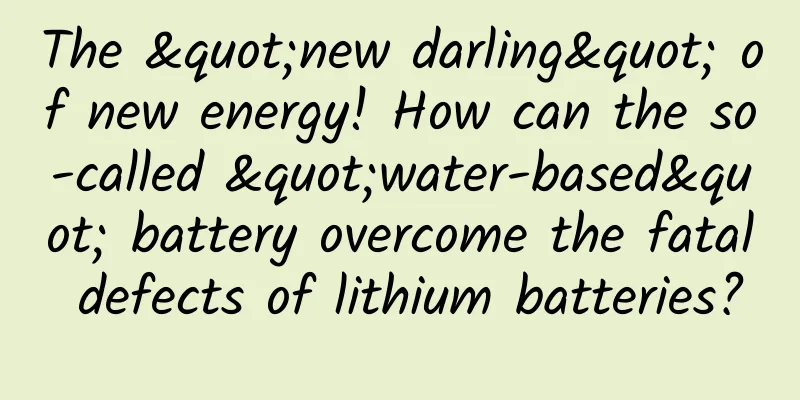The "new darling" of new energy! How can the so-called "water-based" battery overcome the fatal defects of lithium batteries?

|
Energy is the driving force for the development of human society. In recent years, with the determination of the global development goals of "carbon peak and carbon neutrality", large-scale energy storage based on the use of renewable energy and the popularization and promotion of new energy vehicles have also become an inevitable trend of development. People's demand for safe, environmentally friendly, high-energy-density, and low-cost batteries has become more urgent, which has also put forward higher requirements for scientists to explore a new generation of batteries. In this context, aqueous zinc-ion batteries are considered to be one of the most promising sustainable energy storage technologies because of their high safety, low cost, and environmental friendliness. The research direction of Li Xinliang, a professor at the School of Physics, Zhengzhou University, is closely related to this field. ▲Li Xinliang Li Xinliang has devoted himself to scientific research for many years, and has achieved a series of innovative scientific research results in the research and development of water battery/halogen battery energy storage system and electromagnetic wave absorption/shielding devices. "Fortunately, my personal research interests are in line with the needs of national strategic development, so I have overcome difficulties and taken responsibility for this," he said. Keep your feet on the ground and embark on the road of scientific research step by step Everything should be done down to earth. It is easy to do it, but difficult not to do it. Li Xinliang's scientific research path is more like the portrayal of most ordinary students. In 2011, he was admitted to Zhengzhou University of Light Industry, majoring in physics and electronic engineering. At that time, research in energy storage was not popular. During his university years, he had dreams but felt more confused. As he studied energy storage research in depth, Li Xinliang gradually discovered that the scientific research results in this field can be truly applied and transformed. In order to learn more about scientific research knowledge in related fields, after graduating from undergraduate school, he successively studied for a master's degree and a doctorate degree at Northwestern Polytechnical University and City University of Hong Kong. It was also at the later stage that he met Professor Yin Xiaowei and Professor Zhi Chunyi, who had a significant influence on his scientific research career. Li Xinliang said frankly that he went through a period of confusion after graduating from undergraduate school. It was under the guidance of his master's supervisor, Professor Yin Xiaowei, that he set his research direction on radiation-resistant materials and embarked on the road of scientific research step by step. During his time at City University of Hong Kong, under the guidance of his doctoral supervisor, Professor Zhi Chunyi, Li Xinliang combined the research on radiation-resistant materials with the energy storage topic, and carried out research related to safe energy storage and flexible wearable electronics to serve the country's potential needs in civilian and important fields. In addition, during his master's and doctoral studies, the two mentors provided Li Xinliang with a very free scientific research environment, allowing him to give full play to his subjective initiative and continue to explore and move forward driven by his interests. "At the beginning, my plans for scientific research and future goals were vague. It was under their step-by-step guidance that I grew a lot. Without their help, I don't think I would have had much chance to embark on this scientific research path." Li Xinliang said. In order to implement his scientific research work as soon as possible, after graduating with a doctorate, Li Xinliang joined the City University of Hong Kong-Hong Kong Da Zinc Energy Co., Ltd. to engage in scientific research on safe energy storage. Li Xinliang knows that there is still a long way to go from laboratory to enterprise application, especially in the process of laboratory research results to mass production of products, there will be many "scale-up" problems and difficulties. During the time he worked at Hong Kong Da Zinc Energy Co., Ltd., Li Xinliang tried to transform his scientific research work from problem-oriented to research-oriented and application-oriented, which provided him with a more comprehensive perspective for future research topics. Based on the current situation, innovative research on aqueous batteries In September 2020, China clearly put forward the goals of reaching carbon peak by 2030 and achieving carbon neutrality by 2060. As new energy becomes a trend, batteries have been widely used in new energy vehicles, consumer electronic devices and various energy storage power systems. In this social context, Li Xinliang shoulders the responsibility of a scientific researcher and is eager to do something in related fields. As we all know, lithium-ion batteries, which are widely used in new energy vehicles, have the advantages of high energy density, small size, light weight, and long service life. However, lithium batteries require extremely high sealing properties, especially to isolate the water and oxygen environment during service. Once the battery encounters unexpected situations such as collision and extrusion that damage the battery package, the battery cell is very likely to trigger a series of chain exothermic reactions, or even catch fire and explode... In this context, Li Xinliang believes that it is urgent to develop safer, greener, and more stable aqueous batteries to meet the needs of the safe energy storage field that attaches great importance to battery safety characteristics, especially wearable electronics and even implanted medical devices that are in direct contact with the human body. Li Xinliang introduced that aqueous batteries, as an emerging battery technology, have inherent safety and fast charging and discharging capabilities, can extend the battery life and enable the battery to cope with a variety of harsh energy storage/energy supply scenarios, and have broad application prospects in renewable energy storage systems, electric vehicles and portable electronic products. "So the main direction of our current research is to fill the supply chain gap in the safe energy storage market that is not currently applicable to lithium-ion batteries through the development of aqueous batteries. At the same time, in future research, we are also considering incorporating radiation issues under complex electromagnetic/infrared backgrounds into the dynamic assessment range of service safety." He said. During this process, Li Xinliang and his research team first designed the aqueous battery as a whole to ensure that the various components of the battery are highly compatible. Secondly, they introduced temperature and voltage monitoring systems, as well as overcurrent and overvoltage protection devices, to monitor the battery operating status in real time and track the occurrence of abnormal conditions. In addition, they also improved the electrochemical performance while reducing possible side reactions during the service of the aqueous battery through the modification of electrodes and electrolytes, thereby improving the safety and stability of the aqueous battery. Water, the electrolyte carrier in aqueous batteries, is a low-cost, renewable and environmentally friendly solvent. Compared with organic solvents in traditional organic batteries, water has inherent safety, lower cost and less impact on the environment. In addition, aqueous batteries are renewable. Water and metal salts are renewable resources. Regeneration or recycling can reduce resource consumption and reduce the demand for rare metals. However, there is a disadvantage of using water as an electrolyte. That is, the stable voltage window of water is narrow, and it may have side reactions with electrodes, especially the metal negative terminal, resulting in a reduction in the service life of the battery. Based on the relevant research results, Li Xinliang is also committed to developing new high-energy-density halogen batteries. Due to the advantages of halogens such as high redox potential, low cost, and abundant resources, they show great application prospects in electrode materials. In this context, Li Xinliang's team proposed an efficient electrolyte modulation strategy to achieve reversible multivalent state transformation of halogens in conversion-type energy storage systems, and selected safer halide salts as active halogen sources to replace traditional halogen elements as a proof of concept, and constructed an unprecedented high-performance halogen conversion battery based on multi-electron conversion chemistry. It is worth mentioning that through a series of scientific research explorations, they successfully increased the energy density of halogen batteries to more than 200% of the original value, significantly improving the energy storage capacity of halogen batteries. In addition, the new redox mechanism developed by Li Xinliang's team exhibits excellent low-temperature adaptability, which greatly broadens the application scenarios of halogen batteries. Keep a calm mind and promote scientific research Scientific research is a long-term effort. Li Xinliang knows that the improvement of water-based battery performance is not achieved overnight. Sometimes it may take a year or several years to see the results of a performance test, and a series of problems will inevitably be encountered. "When encountering problems, we must first read the literature extensively and learn from others' experiences and lessons. Secondly, we must discuss with our mentors and colleagues and brainstorm. There will always be gains," said Li Xinliang. 2023 is a new turning point in Li Xinliang's life. He returned to his hometown of Henan at the age of 30 and came to the School of Physics of Zhengzhou University to carry out scientific research. "Someone has to come back to fill the 'technological gap', and I am just one of them," he said. As an introduced scientific research talent, both Henan Province and Zhengzhou University and the School of Physics of Zhengzhou University have given Li Xinliang great support in terms of living and scientific research environment, helping him eliminate his worries. Now, for more than half a year, while he has been working non-stop to build his own scientific research team, he has also determined the future direction of his work based on his research foundation. "First of all, with the goal of improving the performance and stability of batteries, we have formulated some exploration plans for the frontier directions and open scientific problems in the field, and through a lot of scientific research practice, we will judge whether the relevant plans are feasible. During this period, it would be great if we can effectively solve some technical problems, propose some basic innovative theoretical models, and advance the field a small step forward," he said. The road ahead is long and arduous. Failures and setbacks are common in the development and exploration of aqueous battery technology, but Li Xinliang always believes that hard work will always pay off. In the near future, he hopes to build a unique scientific research team based on complex and safe energy storage, aiming the research direction at the country's major scientific and technological needs, and strive to make his own contribution. "With technological advances and improved economic feasibility, we can expect to see aqueous battery technology gradually enter the market in the next few years, providing more reliable, environmentally friendly and safe energy solutions for the country, society and ordinary consumers." Li Xinliang said confidently. |
<<: Reverse time and rejuvenate! Is the Turritopsis immortal?
Recommend
WeChat reading product operation analysis!
When using a product, do you suddenly wonder, if ...
iOS9 Learn more every day 3 :: Storyboard References
[[142029]] If you have ever used interface builde...
How can online yoga and fitness seize traffic growth points?
When three people walk together, one of them is f...
Why do some people have no pores? They are just smaller
The simplest meaning of pore is "hole where ...
Trumpchi New Energy released the EV+ solution, Zhang Ruoyun appeared at the Trumpchi booth to support
On April 25, the 18th Beijing International Autom...
In-depth analysis of why Android apps are of low quality and crash
Unlike the situation a few years ago when iOS was...
Revealing the fission tactics of Alibaba, JD.com and other Double Eleven activities!
At this moment, are you browsing your phone while...
Electric fan + mineral water bottle instantly turns into a "cooling artifact", is there any scientific basis for this?
Recently, a short video of "loading mineral ...
Summary of Chinese answering skills 2020 College Entrance Examination Chinese answering template formula novel poetry answering method
Reviewing Chinese in the college entrance examina...
The new generation of artificial intelligence development plan was promulgated, and my country's AI industry will accelerate its catch-up with international standards
2016 can be said to be the year of the explosion o...
[Dry Goods] How to get the first 1,000 valid users at low cost (full version)
First of all, there are two concepts that need to...
What is channel operation?
Channel , we all know that channel has a synonym:...
Are the shelterbelts in the “Three Norths” planted in vain? No, because the sandstorms are “cheating”
Basically every spring, people living in the nort...
Guide to information flow placement in 5 major industries: channel strategies, advertising formats, and creative routines are all included!
Nowadays, mobile programmatic advertising is expe...
Why do you get angry when you're hungry? You may have "hunger rage"!
When you're hungry, do you feel irritable and...


![[Hui Says English] The fifth session of the one-stop English listening and speaking training camp](/upload/images/67cbff5f0e9ad.webp)






